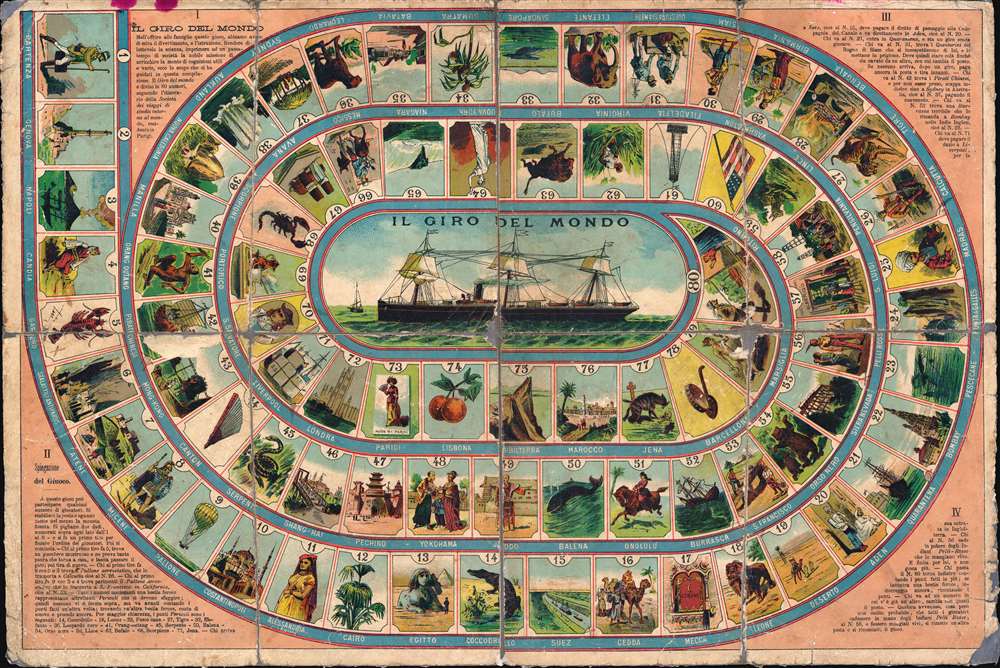This item has been sold, but you can get on the Waitlist to be notified if another example becomes available, or purchase a digital scan.
1890 Achille Italian Jules Verne Chromo Game of Goose Board Game
GirodelMondo-achille-1890
Title
1890 (undated) 16.25 x 24.25 in (41.275 x 61.595 cm)
Description
The Game Board
The game takes the traveler from Milan on a bold round-the-world voyage. Travelers move on to Genoa (2) and Naples (3) before crossing the Mediterranean to visit Constantinople (10) and Cairo (12). Players cross the Suez Canal (15), visiting Jedda and Mecca (17), then across the Indian Ocean to Bombay (22), Madras (25), and Calcutta (26). Onwards, the track leads to Bengal (28), Burma (29), and Siam (30), visits Singapore (33) and Sumatra (34) before heading to sea again, this time to Sydney (37), Manila (40), Shanghai (46) and Peking (47). The next stage takes the traveler across the Pacific to San Francisco (53), St. Louis (57), Pennsylvania (58 - marked by Oil Rigs), and Washington (60). No visit to the U.S. is complete without stopping in New York (64, Statue of Liberty). From New York, the player sets sail to Mexico (66), Porto Rico (69), and then across the Atlantic to Liverpool (71) and London (72). Then homeward, to Lisbon (74), Gibraltar (75), Morocco (76), Barcelona (79), and home. Along the way, there are many dangers and some good fortune. Such may include snakes, grizzly bears, cannibals, hyenas, Chinese pirates, buffalo, crocodiles, lions, and more.Chromolithography
Chromolithography is a color lithographic technique developed in the mid-19th century. The process involved using multiple lithographic stones, one for each color, to yield a rich composite effect. Oftentimes, the process would start with a black base coat upon which subsequent colors were layered. Some chromolithographs used 30 or more separate lithographic stones to achieve the desired effect. Chromolithograph color could also be effectively blended for even more dramatic results. The process became extremely popular in the late 19th and early 20th centuries when it emerged as the dominant method of color printing. The vivid color chromolithography produced made it exceptionally effective for advertising and propaganda imagery.Publication History and Census
The map is undated, but some of the iconography helps us assign an approximate date of 1890. Likewise, no publisher is labeled, but the board was likely printed in Milan by Bertarelli Achille. We know examples on a single hard board, on a board divided at the center, and as here, dissected and laid on linen.Cartographer
Bertarelli Achille (1888 - 1930) was an Italian Milan-based publishing and printing house active in the late 19th and early 20th centuries. The firm specialized in chromolithograph religious iconography, but also expanded to games, music covers, postcards, and other commercial printing. By 1900, the firm has more than 700 workers and a vast premises at Archimede 6, Milan. They further expanded with sales offices in Rome, Naples, Genoa, and Turin. The firm remained active until the 1930s before being done in by the hardships of World War II. More by this mapmaker...

